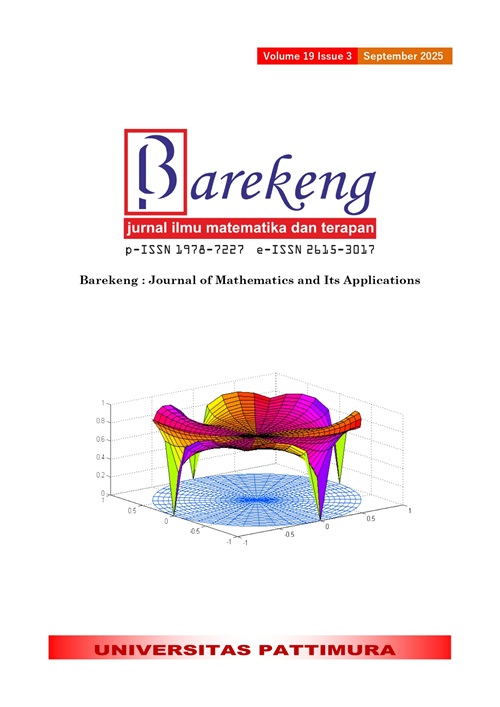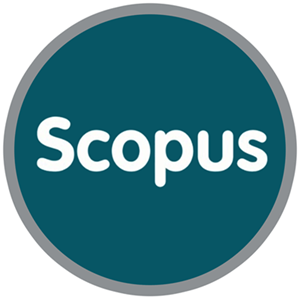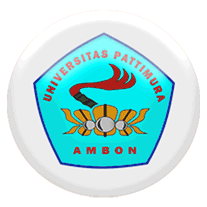LEVEL SOFT GROUP AND ITS PROPERTIES
Abstract
In this paper, we present an application of fuzzy subset and fuzzy subgroup to a soft set and a soft group, thereby creating a soft set and a soft group within the same group. Furthermore, we refer to the soft and soft groups as level soft sets and level soft groups. We also found out the level of soft sets and the operations on soft sets, such as intersection, union, and subset. We also examine what conditions a fuzzy subgroup and a soft group must meet to form a level soft group. Moreover, we scrutinize the properties of operations on a soft set, specifically intersection, union, and AND, and apply them to the level soft group to ascertain if they consistently produce a level soft group over the same set. Furthermore, we investigate the formation of a level soft and level soft group resulting from the homomorphism of the group and soft group. The research findings can enrich studies on the relationships between structures in fuzzy subgroups and soft groups and the application of soft group levels in further research.
Downloads
References
L. A. Zadeh, “FUZZY SETS,” Inf. Control, vol. 8, no. 3, pp. 338–353, 1965, doi: https://doi.org/10.1016/S0019-9958(65)90241-X.
A. Rosenfeld, “FUZZY GROUPS,” J. Math. Anal. Appl., vol. 35, no. 3, pp. 512–517, Sep. 1971, doi: https://doi.org/10.1016/0022-247X(71)90199-5.
S. Abdurrahman, “IMAGE (PRE-IMAGE) HOMOMORFISME INTERIOR SUBGRUP FUZZY,” J. Fourier, vol. 8, no. 1, pp. 15–18, Apr. 2019, doi: https://doi.org/10.14421/fourier.2019.81.15-18.
S. Abdurrahman, “INTERIOR SUBGRUP Ω-FUZZY,” Fibonacci J. Pendidik. Mat. dan Mat., vol. 6, no. 2, pp. 91–98, 2020, doi: https://doi.org/10.24853/fbc.6.2.91-98.
S. Abdurrahman, “HOMOMORPHISMS AND (Λ, µ] – FUZZY SUBGROUP,” AIP Conf. Proc., vol. 2577, no. 1, p. 20001, Jul. 2022, doi: https://doi.org/10.1063/5.0096015
U. Shuaib, M. Shaheryar, and W. Asghar, “ON SOME CHARACTERIZATIONS OF O-FUZZY SUBGROUPS,” Int. J. Math. Comput. Comput. Sci., vol. 13, no. 2, pp. 119–131, 2018.
S. Abdurrahman, Thresye, A. H. Arif, Jumiati, and T. R. Jannah, “HASIL KALI SILANG Ω-SUBSEMIRING FUZZY,” Epsil. J. Mat. Murni Dan Terap., vol. 17, no. 2, pp. 177–185, 2023, doi: DOI: https://doi.org/10.20527/epsilon.v17i2.8748.
S. Abdurrahman, “KARAKTERISTIK SUBSEMIRING FUZZY,” J. Fourier, vol. 9, no. 1, pp. 19–23, 2020, doi: https://doi.org/10.14421/fourier.2020.91.19-23
S. Abdurrahman, Thresye, A. H. Arif, and R. D. Zahroo, “CARTESIAN PRODUCT OF FUZZY SUBSEMIRING,” IN PROCEEDING OF THE 7TH NATIONAL CONFERENCE ON MATHEMATICS AND MATHEMATICS EDUCATION (SENATIK), Semarang, Indonesia: AIP Publishing, 2024, pp. 1–6. doi: 10.1063/5.0194560.
S. Abdurrahman, “IDEAL FUZZY SEMIRING ATAS LEVEL SUBSET,” J. Fourier, vol. 11, no. 1, pp. 1–6, 2022, doi: 10.14421/fourier.2022.111.1-6.doi: https://doi.org/10.14421/fourier.2022.111.1-6
S. Abdurrahman, “CROSS PRODUCT OF IDEAL FUZZY SEMIRING,” Barekeng J. Math. Its Appl., vol. 17, no. 2, pp. 1131–1138, 2023.doi: https://doi.org/10.30598/barekengvol17iss2pp1131-1138
D. Molodtsov, “SOFT SET THEORY—FIRST RESULTS,” Comput. Math. with Appl., vol. 37, no. 4–5, pp. 19–31, Feb. 1999, doi: https://doi.org/10.1016/S0898-1221(99)00056-5.
N. Blackburn and L. Hethelyi, “SOME FURTHER PROPERTIES OF SOFT SUBGROUPS,” Arch. der Math., vol. 69, no. 5, pp. 365–371, Nov. 1997, doi: ttps://doi.org/10.1007/s000130050134.
X. Yin and Z. Liao, “STUDY ON SOFT GROUPS,” J. Comput., vol. 8, no. 4, pp. 960–967, Apr. 2013, doi: https://doi.org/10.4304/jcp.8.4.960-967.
H. Aktaş and N. Çağman, “SOFT SETS AND SOFT GROUPS,” Inf. Sci. (Ny)., vol. 177, no. 13, pp. 2726–2735, Jul. 2007, doi: https://doi.org/10.1016/j.ins.2006.12.008.
R. Barzegar, S. B. Hosseini, and N. Çağman, “SECOND TYPE NILPOTENT SOFT SUBGROUPS,” Afrika Mat., vol. 34, no. 1, pp. 1–16, 2023, doi: ttps://doi.org/10.1007/s13370-023-01045-9.
A. I. Alajlan and A. M. Alghamdi, “SOFT GROUPS AND CHARACTERISTIC SOFT SUBGROUPS,” Symmetry (Basel)., vol. 15, no. 7, 2023, doi: https://doi.org/10.3390/sym15071450
A. Aygünoǧlu and H. Aygün, “INTRODUCTION TO FUZZY SOFT GROUPS,” Comput. Math. with Appl., vol. 58, no. 6, pp. 1279–1286, 2009, doi: https://doi.org/10.1016/j.camwa.2009.07.047.
N. Sarala and B. Suganya, “ON NORMAL FUZZY SOFT GROUP,” Int. J. Math. Trends Technol., vol. 10, no. 2, pp. 70–75, 2014, doi: https://doi.org/10.14445/22315373/IJMTT-V10P512.
Ç. Yildiray, “A NEW APPROACH TO GROUP THEORY VIA SOFT SETS AND L-FUZZY SOFT SETS,” Int. J. Pure Appl. Math., vol. 105, no. 3, pp. 459–475, 2015, doi: https://doi.org/10.12732/ijpam.v105i3.14.
H. Mathematical, “LATTICE ORDERED FUZZY SOFT GROUPS Tahir Mahmood ∗ , and Naveed Ahmad Shah,” vol. 40, no. 3, pp. 457–486, 2018.
C. AKIN, “GP-FUZZY SOFT GROUPS,” Erzincan Üniversitesi Fen Bilim. Enstitüsü Derg., vol. 12, no. 2, pp. 759–770, 2019, doi: https://doi.org/10.18185/erzifbed.486806.
S. Nazmul, “SOME PROPERTIES OF SOFT GROUPS AND FUZZY SOFT GROUPS UNDER SOFT MAPPINGS,” Palest. J. Math., vol. 8, no. 1, pp. 189–199, 2019.
C. Akin, “MULTI-FUZZY SOFT GROUPS,” Soft Comput., vol. 25, no. 1, pp. 137–145, 2021, doi: https://doi.org/10.1007/s00500-020-05471-w.
S. Abdurrahman, “GRUP DAN SUBGRUP,” IN PENGANTAR TEORI GRUP, 1st ed., Banjarbaru: Kalam Emas, 2022, ch. 2, pp. 95–159.
J. N. Mordeson, K. R. Bhutani, and A. Rosenfeld, “FUZZY SUBSETS AND FUZZY SUBGROUPS BT - FUZZY GROUP THEORY,” J. N. MORDESON, K. R. BHUTANI, AND A. ROSENFELD, Eds., Berlin, Heidelberg: Springer Berlin Heidelberg, 2005, pp. 1–39. doi: 1 https://doi.org/10.1007/10936443_1.
S. J. John, “SOFT SETS,” IN SOFT SETS: THEORY AND APPLICATIONS, S. J. John, Ed., Gewerbestrasse 11, 6330 Cham, Switzerland: Springer International Publishing, 2021, ch. 1, pp. 3–36. doi: https://doi.org/10.1007/978-3-030-57654-7_1.
S. Abdurrahman, “SOFT GROUPOID AND ITS PROPERTIES,” Epsil. J. Pure Appl. Math., vol. 18, no. 2, pp. 203–209, 2024, doi: https://doi.org/10.20527/epsilon.v18i2.13781.
Copyright (c) 2025 Saman Abdurrahman, Mochammad Idris, Faisal Faisal, Na’imah Hijriati, Threye Threye, Aprida Siska Lestia

This work is licensed under a Creative Commons Attribution-ShareAlike 4.0 International License.
Authors who publish with this Journal agree to the following terms:
- Author retain copyright and grant the journal right of first publication with the work simultaneously licensed under a creative commons attribution license that allow others to share the work within an acknowledgement of the work’s authorship and initial publication of this journal.
- Authors are able to enter into separate, additional contractual arrangement for the non-exclusive distribution of the journal’s published version of the work (e.g. acknowledgement of its initial publication in this journal).
- Authors are permitted and encouraged to post their work online (e.g. in institutional repositories or on their websites) prior to and during the submission process, as it can lead to productive exchanges, as well as earlier and greater citation of published works.






1.gif)



